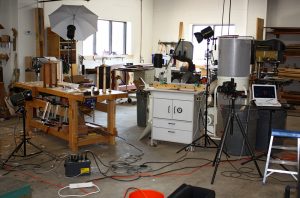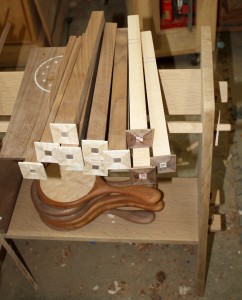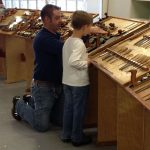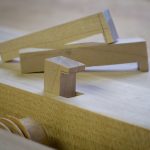We may receive a commission when you use our affiliate links. However, this does not impact our recommendations.
 In real life when you finish a project, you deliver it to a customer, wrap it up as a gift or put it in your house and hope your family says nice things about it. In the curious world of magazines, there is an extra step in between “I’m done” and “what do you think, really?” – the woodworking photo session. It’s a big deal to us because that single image can inspire someone to pick up the magazine and buy it, and perhaps build the project themselves.
In real life when you finish a project, you deliver it to a customer, wrap it up as a gift or put it in your house and hope your family says nice things about it. In the curious world of magazines, there is an extra step in between “I’m done” and “what do you think, really?” – the woodworking photo session. It’s a big deal to us because that single image can inspire someone to pick up the magazine and buy it, and perhaps build the project themselves.
If we’re shooting in the shop, there are a few steps we always go through. With years of experience behind us, we have found that the most attractive images are taken when all the benches in the shop are moved into a position where:
- Actual work on any bench or any nearby machinery would be physically impossible.
- Movement between any two points in the room requires walking around, over or under a bench.
With those things accomplished, as many cables and cords as can be found are placed across any remaining navigational paths. Then the photographer randomly selects tools and puts them in unlikely combinations and positions on the bench. Plane shavings are creatively placed here and there. If we had a larger budget, we would hire a full time shavings fluffer, but our photographer does it himself. If the person who built the project is to be in the picture, the photographer poses him in the most awkward and painful position possible. If not, the person who built the project suggests a point of view that puts the photographer in the most painful and awkward position possible. Paybacks are, well, paybacks. Finally, everyone present enters into a lengthy discussion about the appearance of inconsequential objects in the background.
This week, editor Megan Fitzpatrick threw a new wrinkle into the mix with the suggestion that it would look cool if, in addition to the completed project in the foreground, a couple of in-progress versions of the same project were in the background. That idea wasn’t as farfetched as it may sound, as the “in-progress” pieces were at hand. The reason for that is that I built the project, and I often fall into the trap of “batch production.” Batch processing isn’t listed as a behavioral disorder in the DSM-IV, but perhaps it should be. I blame it on my early training as a cabinetmaker. The reasoning goes like this: “As long as I’m setting up to make this, I might as well make some extra parts. Since I have these extra parts, I might as well make a second one, or even a third.”
Things got out of hand with this project. In addition to being an article for the magazine, we shot a video during construction. So I made a prototype first, to determine the best processes to show in print and in video. I gathered enough wood for two: one for the article and one for the video. Then I began to wonder if the wood combinations (tiger maple and ebonized walnut) might look better with the pieces reversed. So I gathered enough wood to make two that way. Then I showed my wife a picture of the original, which was painted. So I gathered wood to make a plain version so that she (not me) could take a stab at reproducing the original painting.
 After completing the prototype, I cut parts for five more. At the moment, I only have one finished, the one that will appear in the magazine. The prototype is close, but I need to find a Saturday afternoon to smooth out the rough parts and do the details. The one that will be painted is about halfway, maybe I can do it the Sunday after the Saturday. The others will probably stay as parts for a while. I need to move on to future projects. So I stacked the pieces out of the way for the photo shoot. On top of a half-finished project, and above extras for another half-finished project.
After completing the prototype, I cut parts for five more. At the moment, I only have one finished, the one that will appear in the magazine. The prototype is close, but I need to find a Saturday afternoon to smooth out the rough parts and do the details. The one that will be painted is about halfway, maybe I can do it the Sunday after the Saturday. The others will probably stay as parts for a while. I need to move on to future projects. So I stacked the pieces out of the way for the photo shoot. On top of a half-finished project, and above extras for another half-finished project.
Note, the projects in the photo above were featured in articles for Popular Woodworking Magazine. You can find the original articles (and a whole bunch more) in our back issue archive disc, on sale now in our store.
Here are some supplies and tools we find essential in our everyday work around the shop. We may receive a commission from sales referred by our links; however, we have carefully selected these products for their usefulness and quality.










I read this aloud to my wife who serves as my photographer, stylist and artistic shavings distributor. Much laughter ensued. Thanks for sharing. We do not have quite as many lights, cords and cables as you show, but that image gives us inspiration for developing our skills and toy acquisitions.
The image in your article appears to be a professional photo shoot of a professional photo shoot of your project…. Do you have a photo shoot of the photo shoot of the photo shoot of the project? 🙂
Hilarious 🙂
OCD is a side effect of the woodworking gene. 😉
I know I’ve worried about many of the same things over the years.
How is it that your writing’s just as good as your woodworking? Not fair. 🙁